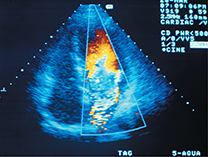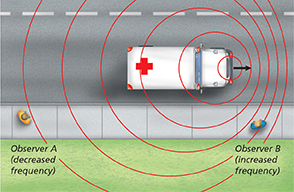Ultrasound
Most people hear sounds between 20 hertz and 20,000 hertz. Infrasound is sound at frequencies lower than most people can hear, and ultrasound is sound at frequencies higher than most people hear.  Ultrasound is used in a variety of applications, including sonar and ultrasound imaging.
Ultrasound is used in a variety of applications, including sonar and ultrasound imaging.
Figure 17 Ultrasound can be used to make images of the heart, which help doctors diagnose disease.

Sonar is a technique for determining the distance to an object under water. Sonar stands for sound navigation and ranging. The distance to the object is calculated using the speed of sound in water and the time that the sound wave takes to reach an object and the echo takes to return.
Ultrasound imaging is an important medical technique. Figure 17 shows an image of the heart made by sending ultrasound pulses into a patient. A pulse is a very short burst of a wave. Each ultrasound pulse is short—about of a second—so that it doesn't interfere with the reflected pulse. Computer software uses the reflected pulses to make a detailed map of structures and organs inside the body.
The Doppler Effect
Perhaps you have heard the pitch of a siren change as it passed you. This is the Doppler effect—a change in sound frequency caused by motion of the sound source, motion of the listener, or both. The Doppler effect was discovered by the Austrian scientist Christian Doppler (1803–1853).
 As a source of sound approaches, an observer hears a higher frequency. When the sound source moves away, the observer hears a lower frequency. Figure 18 shows a single frequency emitted by the ambulance siren. As the ambulance moves toward observer B, the wave fronts bunch together. Observer B hears a higher frequency than the frequency of the source. For observer A, however, the wave fronts are spread out, and the frequency is lower than the source frequency.
As a source of sound approaches, an observer hears a higher frequency. When the sound source moves away, the observer hears a lower frequency. Figure 18 shows a single frequency emitted by the ambulance siren. As the ambulance moves toward observer B, the wave fronts bunch together. Observer B hears a higher frequency than the frequency of the source. For observer A, however, the wave fronts are spread out, and the frequency is lower than the source frequency.
Figure 18 Observer A hears a lower-pitch sound than observer B because the wave fronts are farther apart for observer A. Inferring What can you infer about the pitch the ambulance driver hears?
 d
d




